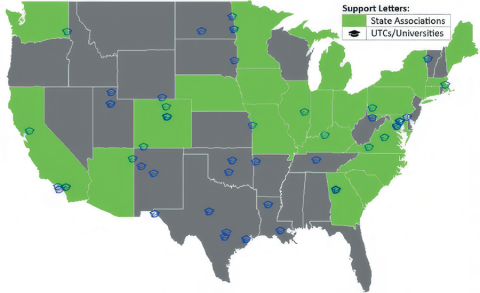Aggregates in the Low-Carbon Transportation Material Market

by Hadi Rashidi, NSSGA
The construction industry is increasingly focused on sustainability, and aggregate producers play a crucial role in the supply chain. The Inflation Reduction Act (IRA) includes provisions that strongly encourage and facilitate the development and use of Environmental Product Declarations (EPDs) for essential construction materials, such as concrete, asphalt, steel and glass, indirectly affecting aggregate producers through their primary markets: asphalt and concrete.
The IRA’s support for developing and using EPDs reflects the growing emphasis on sustainability in construction. Some asphalt and concrete producers are already seeking EPDs from aggregate suppliers. This trend will only intensify as more states adopt legislation or executive orders requiring EPDs for Department of Transportation (DOT) projects. Additionally, many commercial clients are demanding EPDs and low-carbon materials.
You might feel insulated from these changes if you are an aggregate producer operating in a state without such legislation or not dealing with federally funded projects. Preparing for these shifts, however, can open access to a new market for low-carbon materials, which many might overlook.

This is not just a decision for producers but also for state decision-makers. The Federal Highway Administration (FHWA) recently announced the $2 billion Low Carbon Transportation Material grant program, with $1.2 billion dedicated to states and $800 million for non-state agencies. Only 30 states are expected to apply for the grant at the time of writing, indicating that some are passing on these opportunities even at the state level.
The Future of EPDs and Low-Carbon Construction Materials
EPDs are not the goal but a starting point for collecting industry data, setting benchmarks and driving improvements. Discussions are ongoing on how to use procurement to drive competition in lowering embodied carbon, whether through incentives or other means. Asphalt and concrete ready-mix producers are already thinking about how to gain an advantage in the market by lowering the embodied carbon of their products, which also affects their choice of upstream sources, including aggregate suppliers.
Factors Affecting Supplier Choice in a Low-Carbon Material Market
Proximity to the Market
A report by the National Asphalt Pavement Association (NAPA) highlights that the aggregates share of carbon footprint of upstream production (A1) for asphalt mixtures is about 6 percent, with literature suggesting an even smaller share in concrete. While the cradle-to-gate embodied carbon of aggregates products (covering phases A1-A3: raw material supply, transportation and production) is relatively low, for the downstream products that is only the A1, and the transportation of aggregates from the production facility to their plants is the A2 stage of their own cradle-to-gate EPD. Thus, the proximity of aggregate sources to downstream production facilities becomes a critical factor, as shorter transportation distances will lower the EPD reported global warming potential (GWP) of the asphalt and concrete.
Availability of EPDs for Your Products
Collecting data to create EPDs for your products is essential. The Theta Tool by WAP Sustainability is currently available for aggregate producers to create EPDs. NSSGA has applied for an EPA grant to reimburse the industry for the cost of using such tools and possibly developing new tools to address the current and future needs for robust data collection and reporting. NSSGA will announce the outcome in a few weeks.
Other Improvements
NSSGA hired WAP Sustainability to conduct a Life Cycle Assessment (LCA) analysis to develop the construction aggregate Product Category Rule (PCR). This report, currently available by request, indicates that the energy source and use of explosives are two of the most important factors affecting the Global Warming Potential (GWP) in EPDs for aggregates.
By addressing these factors, aggregate producers can better position themselves in the evolving market for low-carbon construction materials.
The Role of Trade Associations
NSSGA received letters of support from 23 state trade associations to apply for EPA grants through a cooperative agreement. The NSSGA application included five major areas:
- Becoming the program operator for aggregate EPDs.
- Providing cost reimbursement to the industry for issuing EPDs.
- Developing additional tools to support the industry for robust data collection.
- Offering education and training for the industry.
- Developing industry guidelines for best practices on Enhanced Rock Weathering (ERW) and Carbonation of Recycled Concrete Aggregate (RCA).
If the grant is awarded, NSSGA plans to work with state associations to maximize the program’s reach and benefits across the industry. NSSGA expects to hear from the EPA soon about the outcome of this application and will keep our members informed about how they can benefit from this program.
Originally published in July/Aug. 2024 Stone, Sand & Gravel REVIEW.

